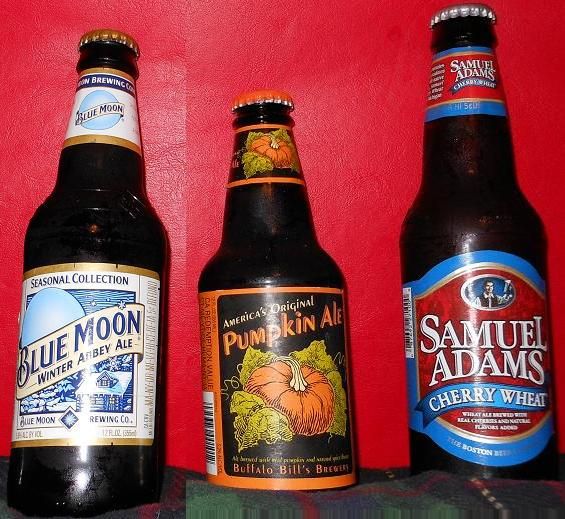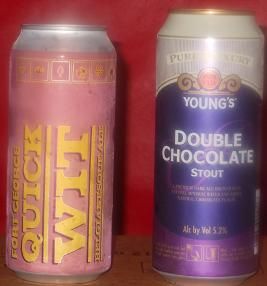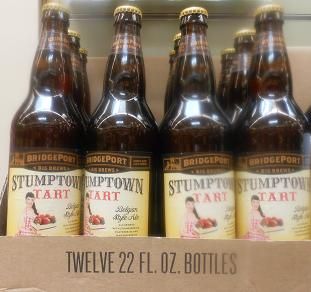
Last winter these became my 3 favorite beers.
From left to right: Blue Moon's Winter Abbey Ale, Buffalo Bill's Pumpkin Ale,
and Samuel Adams Cherry Wheat
In some of my blogs I have casually written the fact that I like to drink beer. This little blog is more to the point, roll out the barrel and read 'bout it here. I like beer. ~ Paraphrased from Tom T. Hall's "I Like Beer"
For first religious reasons, then personal reasons, I didn't drink alcohol of any kind for the first 37 years of my life. However, in late 2007 my beliefs began to change, as beliefs tend to do, and I quickly found myself to be a pretty enthusiastic wine drinker and buff. I kept up on wine reviews, studied pairing guides, joined online discussion groups, and was always eager to try a new vintage. Wine had become a quasi hobby in a very short time.
Lately though, I've noticed, that when I'm given a choice, I'm more likely to order a beer over a glass of wine. I began thinking about this migration in my beverage preference the other day, and wondered had been at the root of this shift.

Left: Quick Wit Beer from Fort George Brewing out of Astoria, Oregon.
Right: Young's Double Chocolate Stout from Bedford, England.
(Hover your mouse pointer over each link above to read my micro review of each beer.)
My diet may have something to with the answer. No doubt, a good plate of pasta, most seafood dishes, a cheese course, and roasted holiday fowl all still cry out for a good glass of wine. Yet, while it's certainly possible to pair wine with everyday fare such as; a burger, meatloaf, hotdogs, pizza, tacos, kielbasa, pork chops, or just a salami sandwich; these things simply seem to go better with beer. Even a good steak seems heartier, and a bowl of popcorn during a boxing match seems tastier, when accompanied by a cold one with a good head on it.
The food pairing answer, alone, didn't really satisfy me though, so I buckled down and did some research on the subject.
Mostly because it's mentioned through out the Bible, I grew up under the impression that wine was the first alcoholic beverage, and beer came later. Turns out, I was dead wrong. Dr. Solomon Katz, prominent anthropologist, theorizes that when man learned to ferment grain into beer, more than 10,000 years ago, it became a crucial nutritional staple by providing early man with dietary protein which unfermented grain couldn't deliver.
While their wasn't an understanding of beer being a protein delivery system, people recognized that beer drinkers were generally healthier than drinkers of raw water. Of course, besides the protein, beer drinkers became sick less often because the beer was more sanitary than local water supplies, as the brewing process killed any pathogens.
In order to have a steady supply of beer, man had to give up his nomadic ways, settle down, and begin farming. That's right, we went from being hunters & gathers to being agricultural species in order to ensure our access to beer. Talk about an evolutionary catalyst.
Since then, beer has been a steady presence in human history. Ancient Sumerians have the earliest written record mentioning beer. Many of heir prayers or songs to their gods mention beer, including the Hymn to Ninkasi,which can be read as an actual recipe for beer.
Biblically speaking, Professor of Crop Science at North Carolina State University, Thomas R. Sinclair, speculates that Noah, yes that Noah, had probably been a beer trader along the Euphrates River when the historic storm hit. While I'm not certain as to the accuracy of Sinclair's theory, a 2000 year old Assyrian tablet does state that Noah had an ample provision of beer aboard his ark for the voyage.
Fast forward a few thousand years, and we find beer present, almost omnipresent, during the earliest days of the American Colonies. For the same health reasons as described above, most American adults drank home brewed Hearty Beer pretty much exclusively. Their children & servants drank a less alcoholic creation known as Small Beer, made from the third running of the grain mash.
This home brew was replaced by commercially made beer in 1683 when William Penn established one of the Americas' first factories, a brewery. Its opening was soon followed by the founding of several other breweries across the colonies. The surge in commercially produced brews lead to the emergence of pubs, where these beers could be consumed as men caught up on the day's news.

Like Washington, James Madison was a beer aficionado in his own right. It was Madison who proposed adding a Secretary of Beer to the Cabinet during the formation of the Federal Government. Surprisingly, it was Ben Franklin who raised an objection to the post, claiming that the consumption of beer was a bit too prevalent within the colonies. Yet, Franklin himself was fond of brewing and consuming a Spruce Beer rich with molasses and other sugars.
The taste for varied ales dominated American palates until the mid 19th century when German immigrants brought the colder brewed pilsner style beers with them to America. Unlike modern pilsners and lagers, these were rich flavorful pale beers which caught on quickly and pushed many of their predecessors from the market.
In the mid 1860s, Pabst, Miller, Schlitz, and Anheuser-Busch began mass production of pilsners, and similar "easy drinking" lagers. By 1873 these companies were utilizing cutting edge technology, such as cold rail cars, to ship their product across the country.
Small breweries still competed with the big four, in local markets, until the 1920s when prohibition hit. In order to survive, the big four were able to diversify, making everything from soda pop to syrup and ice cream. Unfortunately, most small beer makers couldn't survive the decade long ban, and were forced out of business.
When the 21st Amendment was finally passed, America was left with a virtual lager monopoly. Mass production had lead to a market of generally watery weak tasting beverages. Even most of the smaller breweries, which were still around, such as South Bend's Drewry Beer, found themselves in the pale lager business. Mid-twentieth century innovation eventually gave consumers a choice between regular and "lite" beer, but that was pretty much the extent of one's choice.
Enter Fritz Maytag, who bought Anchor Brewing in 1965. He approached beer making from a chef's point of view, using superior ingredients, six row grain instead of traditional two row grain for example, to make an ale, porter, small beer, and Christmas beer. Success was far from immediate, but years of experimentation, productions of one time limited addition brews, and attention to detail eventually lead to Maytag saving the company and sparking the craft beer movement of the 80s and beyond.

2012 Stumptown Tart Belgian Style Ale from BridePort Brewing out of Portland, Oregon.
(Hover your mouse pointer over the link above to read my micro review of this beer.)
As of August 6, 2012, the Brewers Association reports there being a total of 2,126 U.S. breweries, with 2,075 (97%) of them qualifying as being craft breweries. This number includes 1,195 Brewpubs, 790 Microbreweries, and 90 Regional Craft Breweries.
Just in my lifetime, we've gone from a pilsner/lager dominated market to a more versatile colonial style selection featuring beers flavored with chocolate, coffee, vanilla, citrus fruit, honey, hot peppers, berries, and almost anything else you can think of. While I have yet to come across a meat flavored beer, I wouldn't be surprised to see one on the grocery shelf tomorrow.
Most recently, perhaps inspired by his distant forebear, George Washington, President Obama has entered the craft beer arena with a White House line of craft beers; Honey Ale, Honey Blonde, and Honey Porter. Whether it's hype or not, rumor has it that multiple home brew enthusiasts are clambering for the recipes on Twitter & Facebook.
So, what does all this have to do with my taste migrating, to a large degree, from wine to beer? I don't know?
OK, the increase in variety is doubtlessly a key factor. If all I had access to was Bud and his watery brethren, I wouldn't touch beer. In MY OPINION, Bud is to beer what Wonder Bread is to bakery fresh bread, a cheap knock off. Today though, not only can I easily find great tasting beer, I can literally select the right beer for the right job. I can enjoy a Young's Double Chocolate Stout alongside a rich hearty beef stew, I can enjoy a Quick Wit with a good steak or burger off the grill, or I can down a Samuel Adams Cherry Wheat while watching sports and polishing of a bag of chips.
The only other factor I can think of, is math. Think about it. Order a glass of wine at a restaurant and you'll get 3 to 4 ounces. Seriously, it's usually gone before your meal's finished. Order a beer though, and they'll offer you a choice of 12, 16, or sometimes 22 ounces or more. That beer has a much better chance of lasting for the duration of the meal. Likewise, at a private dinner/cocktail party, if one takes a "deep pour" (over 4 ounces) one is looked down on as being rude. Yet with beer, one is expected to fill one's; glass, mug, stein.
This difference in attitude is almost solely a reaction to the difference in price. BEER COSTS LESS! Excluding ancient dust covered bottles and high end bubblies, you can get a "good wine" for between $15 & $40. You can go much higher, but that range will get you a pretty decent bottle. From that bottle, one may get between 4 to 6 glasses of wine. That same $15, maybe as high as $18, will get a buyer two six packs of 12 ounce bottles of most craft beers I can think of. Thus, the low end of the price range will get a buyer twice to three times more drinks of beer than wine.
Make no mistake, good wine will always have a place at my table. However, whether due to food pairing options, variety of ingredients, depth of pour, economics, taste, or some factor which has yet to dawn on me, the fact is that beer is more likely to be my everyday beverage.
-
Food Recipes Using Beer
Recipes prints as pages 5 & 6 for your fridge or recipe file.
-
Outback-esc SteakPersonally, I love Outback's seasoned steaks. I forget where I found this recipe years ago, but it mimics the taste pretty closely. I usually leave the MSG out, or it might be spot on.
1 Cup Full Sail Ale
2 tsp Brown Sugar
1/2 Tsp McCormick Montreal Steak Seasoning
1/4 Tsp Ground Black Pepper
1/4 Tsp MSG
Place your favorite cut of steak in a shallow pan and pour ale on steak and marinate for hour in refrigerator. Remove steak from ale and mix dry ingredients together and rub steak on both sides. Let marinate with dry ingredients for 1/2 hour. Preheat a skillet or grill to med high heat add vegetable spray or vegetable oil and braise to perfection.
-
Beer Can ChickenAs I understand legend, a team of Air Force pilots were cooking out on their day off when, for reasons since lost to history, one of them hit upon the idea to penetrate the roasting chicken's butt with a can of beer. Multiple versions of Beer Can Chicken have been published since then. I found this one on About BBQ's Website.
Prep Time: 15 minutes
Cook Time: 2 hours
Total Time: 2 hours, 15 minutes
Yield: Serves 4
1 whole chicken (about 4 pounds)
1 12 ounce can beer (room temperature)
2 cloves garlic, minced
2 sprigs fresh rosemary
2 teaspoons olive oil
1 teaspoon dried thyme
1/2 teaspoon red pepper flakes, crushed
Juice of 1 lemon
For Rub:
1 teaspoon paprika
1 teaspoon salt
1 teaspoon fresh rosemary, chopped
1 teaspoon dried thyme
1/2 teaspoon black pepper, ground
1/2 teaspoon lemon zest
Combine all rub ingredients in a small mixing bowl. Set aside.
Remove giblets and the neck from chicken. Sprinkle all over with rub, including cavity. Open can of beer and discard half of it. Place, minced garlic, rosemary, thyme, lemon juice, and pepper flakes in it. Make sure to pierce two more holes on the top of beer can. Place chicken on top of can.
Preheat grill for a medium heat. Place birds on grill balanced by the beer cans. Grill over indirect medium heat for 1 1/2 to 2 hours until internal temperature of thigh is 180 degrees. Remove chicken when finished cooking and let sit (with beer can still intact), for 10 minutes before carving.
-
-
Drink Happily & Responsibly! :-D

No comments:
Post a Comment